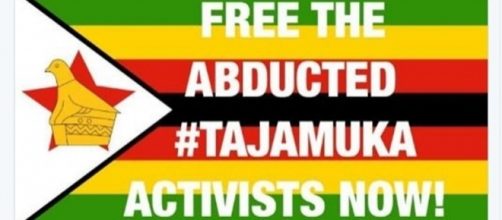Through social media journalists, Independent writers, The Guardian and Reuters, the Quiet Revolution in Zimbabwe made world headlines after a week of protests, work stay-aways, strikes and unrest in the country which saw scores of videos and photos posted online to show “Police brutality” against Zimbabwe citizens.
Fears for activist leaders.
The Shutdown Zimbabwe, Tajamuka and This Flag movements have been aware that sooner or later the government would take tough steps to contain those engaged in leading what some have termed a social revolution similar to The Arab Spring.
Tweets have been mentioning the fate of Itai Dzamara who disappeared 16 months ago and it is feared he may be dead. Fearsthat some of the current activists for change might suffer a similar fate may have come true as #This Flag have issued a statement that two activists - Lawrence Tembedza & Austin Nyakupinda were abducted by armed gunmen in the middle of the night, exactly the same way Itai was taken.
Situation in #Zimbabwe #ThisFlag #AfricaIsOneCountry @ali_naka Please read and retweet. Spread the word. pic.twitter.com/5Ka0nLUTuN
— #CITIZEN'SVOICE (@TJozra) July 8, 2016
Protests and unrest.
The protests and unrest hit the headlines with the burning of a customs warehouse in Beitbridge and the resultant closure of the border at Beitbridge between South Africa and Zimbabwe.
Previous to this there were protests in the small town of Rusape. Tuesday saw taxies and touts clashing with police as they protested the amount of police checkpoints on the roads and cited them as just a way the police could extort money. Wednesday, the Quiet Revolution called for a massive stay-away. Images on Twitter show this was quite effective. The government newspapers reported it was a flop, but the thousands of images showing empty streets possibly belie the government stance.
Efforts to stop the protestors.
The government of Zimbabwe issued a number of warnings to citizens that if they continued to tweet about the unrest this would be viewed as illegal, and subsequently there were reports that police checkpoints were demanding to see smart phones to look for any images of the unrest – most of which involved scenes of riot police beating up protesters.
A desperate regime that is out of touch with technology and its people. Eff off! pic.twitter.com/1Zi6MxQoaM
— Gutuboy (@AlekeMukunga) July 7, 2016
In addition to this it has been reported, and backed up with images across social media that the Zimbabwean government has deployed their army and police to deal with the protests. The government has said that there is a 3rd force involved and that the protests have been organised by western nation embassies which has angered the protesters who think it is time the government realized that Zimbabweans can think for themselves. There have been some violent actions, particularly in Bulawayo in the west of the country, and activists are calling for a continuation of peaceful protests without destruction.
N the news didn't even talk abwt this #thisflag pic.twitter.com/S6TR383FWk
— Je SUIS (@kievzim) July 7, 2016
The way forward.
The way forward appears to a little confused, as the Tweeters are working under a number of Hashtags, including #This Flag, #ShutdownZimbabwe2016, and Tajamuka, amongst others. Some protesters are calling for a mass march on Government House on the 9th July.
THE BEGINNING OF THE END. #ThisFlag #ShutDownZimbabwe2016 pic.twitter.com/u9Wnb18X4Y
— Our Zimbabwe (@Reformzimbabwe) July 7, 2016
Others are saying that it is time to wait while the government considers their demands or they will orchestrate another stay-away next Wednesday and a Reuters report suggested that others want to continue the action until Mugabe resigns and their demands are met.
From tweets to streets, Zimbabwe social media #ThisFlag anger erupts into anti-Mugabe protests https://t.co/KpKASG1fOY via @Reuters
— Jeremy Wagstaff (@loosewire) July 8, 2016
The demands.
The demands seem reasonable enough to others in democratic countries and include:
- Fire corrupt cabinet Ministers.
- Remove police roadblocks (Checkpoints)
- Pay civil servants on time
- Abandon the bond notes
- Lift the import ban.
A sixth demand has just been added, which is for the government to release the two abducted activists immediately. In all of this there is a seventh demand which is unlikely to be met and these are calls for Robert Mugabe to stand down.

